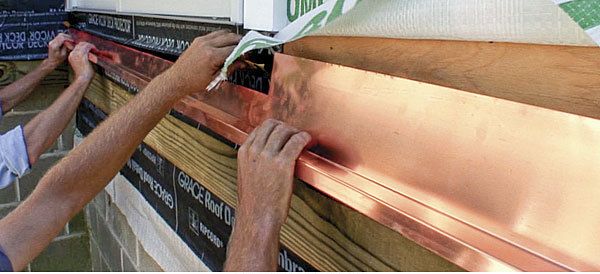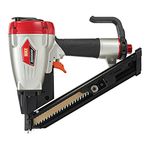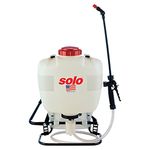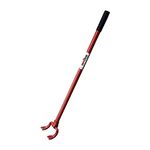
Proper flashing of a deck ledger is crucial to preventing water from getting behind the ledger and damaging it and the sheathing underneath, a key cause of premature deck failure. Ledgers can be flashed with many materials. Among the most common are copper, vinyl, galvanized steel, stainless steel, and aluminum, although not all of these are easy to find in all locations. FHB editorial adviser Mike Guertin, an expert deck builder, says that all these materials can flash a deck ledger adequately. “The design and installation of the flashing material are more important than the material when it comes to successful durability,” he explains. Installing one of these materials correctly, however, requires knowing what makes it different from the rest. All except for stainless steel and copper are available in both rolls and factory-bent panels. Rolled products are best bent on a sheet-metal brake.
Copper
This traditional flashing material is durable and compatible with CA- and ACQ-treated lumber. It is expensive, however. At least two manufacturers sell flashing with a sheet of copper on one side and a sheet of polypropylene on the other. Not only is it a good bit cheaper ($45 to $68 for a 12-in. by 20-ft. roll) than straight copper, but it also can be formed by hand.
14-in. by 10-ft. roll: $125
Vinyl
Vinyl lasts indefinitely and won’t dent. If treated with a UV inhibitor, it also resists fading and cracking. As with other vinyl products, vinyl flashing moves with changes in temperature. To accommodate this movement, cut slotted holes for fasteners (stainless steel or hot-dipped galvanized) if they’re not already there, and nail the fasteners loosely. Vinyl flashing is generally available in white and tan.
14-in. by 30-ft. roll: $20 15⁄8-in. by 8-ft. panel: $10
Galvanized Steel
Using a peel-and-stick membrane is a good idea with galvanized-steel flashing, whose zinc-covered surface degrades over time, especially in coastal environments. Frequent application of rock salt and certain other deicing chemicals on a deck also can speed up corrosion. For the best protection, choose G185 galvanized steel, which has 1.85 oz. of zinc coating per sq. ft.
14 in. by 25 ft. roll: $19 15⁄8-in. by 8-ft. panel: $20
Stainless Steel
Stainless steel is Guertin’s favorite material for flashing deck ledgers. In his coastal New England environment, stainless steel holds up very well on homes near salt water. It does the same on decks that receive salt during the winter to melt ice.
15⁄8-in. by 8-ft. panel: $30
Aluminum
Aluminum was the most common flashing material until CA and ACQ replaced CCA for treating lumber. Both chemicals contain more copper than CCA, which means that they corrode aluminum flashing. Separating the aluminum from the lumber with a peel-and-stick membrane is one way around this problem, but it adds a step to the installation process, not to mention an additional cost. Still, aluminum is inexpensive and readily available, so for some builders, particularly those in regions that receive little rainfall, this extra step may be worth it.
14-in. by 10-ft. roll: $6.50 15⁄8-in. by 8-ft. panel (painted): $21
Fine Homebuilding Recommended Products
Fine Homebuilding receives a commission for items purchased through links on this site, including Amazon Associates and other affiliate advertising programs.

Metal Connector Nailer

4-Gallon Piston Backpack Sprayer

Angel Guard Deck Demon






























View Comments
I don't disagree with anything you say above, as i am sure you checked your facts, but the truth is; 1). ALL of the above flashing materials expand and contract and therefore should be fit with horizontal slotted fasteners and some form method to allow for the movement. Oversizing holes by 1/8" all around should be enough for 10' lengths of any of these. But when you apply them over bolts, first add a stop bolt followed by a nylon washer, then the flashing, the ledger board, and another bolt finger tightened but not so tight as to prevent movement. About a dime thickness off the face is good. Then apply a second bolt tightened next to the first outside bolt, using one wrench to hold the first in place while you tighten with another.. They will tighten together and not move, and allow the ledger and flashing to move. Keep in mind this means you will only be relying on bolts firmly secured to the house framing and that the weight of your deck will be carried by the shear strength of the bolts and no compression force.
2). I find it silly to see your prices vary so little for 10' lengths. Stainless steel, would clearly be the first and the best, yet your pricing shows that for 10' lengths, if you assumed a long deck of 50', you need 5 of each or whichever you choose. Cost variations of any 14" choice would be $550 for 50 feet of copper; $150 for stainless steel; $105 for Aluminum in panels or $35 for rolls (do not understand such a difference (which should be never used anyway as a choice in my opinion); $76 for galvanized in rolls, or $95 for galvanized sheets; $40 for vinyl in rolls, and $60 for vinyl in sheets.
In the north and south where you have a lot of moisture, you should either use double hot dipped galv. (G195) bolts and nuts, or Stainless steel (410). Never use non treated. There are also other coatings on the market that are weatherproof as made by many manufacturers including epoxy and powder coat treatments. Zmax is the preferred galvanizing of choice. Copper will react with zinc, so make sure it is separated with a nylon or neoprene or epdm self-adhering material; Also, realize copper will darken and often stain woods and other surfaces when water runs down over years and years.
I would not risk a high quality deck with copper or anything but Stainless steel. If you can afford the wood, you can afford the Stainless steel bolts. Unless you are on the waterfront, you can use the zmax galvanized post supports and joist hangers. I have seen normal zinc treated galvanized steel hangers rust right through because the coatings flake or scratch off during nailing.
Galvanized sheet steel comes in at least 4 levels of treatment i am aware of and likely more. Do not ever bother with electro-galv.
I hope some of you find this useful info.
one more point i wish to make; ideally you should use self adhering epdm or other rubberized material to overlap metal drip flashing, and above to the plywood sheathing. The housewrap then overlaps the metal. Reason for this is that water usually gets into and behind housewraps and metal in front won't do a thing.
And, above comment regarding expansion and detail for accommodating such was referring to bolting through ledger boards and flashing at the same time. Some contractors install two layers of flashing drips; one at the deck and the other below the ledger.